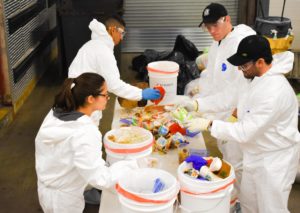Today, “sustainability”, “eco-friendly”, “fair-trade”, and “recyclable” are more than just buzzwords, they’re at the forefront of new product designs targeting increasingly eco-conscious consumers while also delivering more equitable and sustainable returns on investments as they spur future growth.
Partly due to consumer demand, and partly thanks to the ESG framework laid out by former United Nations Secretary-General Kofi Annan, today’s forward-thinking companies already know that social and environmental initiatives and innovations are key to future success. The realization has set in that it is possible to reduce our environmental impact and maintain long-term growth at the same time.

While many brands are now committing to more sustainable production, distribution, and end-of-life waste management while simultaneously minimizing their carbon footprint, it’s important to ensure products labeled as “green” are in fact environmentally friendly.
In the race towards consumer-oriented sustainability, greenwashing is a term becoming the antithesis of social and environmental responsibility. It takes many forms. It can be extremely simple, such as imagery of the natural world incorporated into the packaging of processed foods, or it can be complex and difficult to untangle, with regulatory tests rigged and data presented in a way that skews consumer perception through green marketing. Put simply, to greenwash is to engage in both subtle and obvious practices that place earning over environmentalism.
Here, we look at the concept of greenwashing to identify and avoid it and explore the implications it has on both corporate and social responsibility.
What is greenwashing and why do consumers need to be aware of it?
Greenwashing, a take on the term “whitewashing”, is essentially a marketing tool used to deceive consumers into believing a product or brand is environmentally friendly. First coined in 1986 by environmentalist Jay Westerveld in relation to hoteliers promoting the reuse of towels as an energy-saving “green” initiative, Westerveld found little evidence that these companies were working towards the reduction of waste energy and subsequently identified the initiative as purely profit-oriented with little to no environmental benefits.
At its core, greenwashing is exactly this; an outward show of environmental responsibility that, when examined, is a tactic to increase profits or boost brand image.
It can also be confusing with a plethora of regulatory standards laid out by both government and NGOs often contradicting one another or blending into each other. Additionally, with the exception of ESG (PRI) standards, there’s no overarching framework to bring all of these disparate standards together—meaning while adopting one of these labels may imply a sustainable product, there are other considerations that may make it less sustainable than claimed.
But there’s more, and TerraChoice Environmental Marketing laid out a set of “seven sins” that characterized current greenwashing practices:
- The hidden trade-off — Claiming “green” qualities without paying due attention to other environmentally harmful practices.
- No proof — Claiming products are “green” without providing easily accessible evidence or supporting material.
- Vagueness — Claiming products are “green” with extremely broad or misleading claims.
- Irrelevance — Claiming products are “green” by including irrelevant information designed to mislead the consumer looking to purchase green products.
- Lesser of two evils — Claiming products are “green” by using environmentally sound practices that create harmful products.
- Fibbing — Claiming products are “green” simply by lying or stating falsehoods.
- False labels — Claiming products are “green” by including third-party certification with fake labels or claims of endorsement.
Examples of greenwashing
Is the label FSC (Forest Stewardship Council) important when a product is wrapped three times in plastic? What does non-GMO mean when corn is fertilized using chemicals that may be harmful to human health and the environment. Can you trust the data presented by some of the world’s largest brands? Are plastic bottles as recyclable as claimed?
 All of these are important questions when it comes to the concept of greenwashing, and there are, in fact, countless examples of what greenwashing can do to change consumer perception – both intentional and unintentional, historical and contemporary.
All of these are important questions when it comes to the concept of greenwashing, and there are, in fact, countless examples of what greenwashing can do to change consumer perception – both intentional and unintentional, historical and contemporary.
Recently, car manufacturer Volkswagen made the headlines as one of the most famous examples of greenwashing within the automotive industry. The company presented its diesel vehicles as “clean” (meaning lower greenhouse gas emissions than the legal limit), which was subsequently authorized by the EPA and other international regulatory bodies. However, after having admitted to rigging some 11 million of its own diesel cars to cheat regulatory tests, the company was fined 2.8 billion dollars.
Reynolds American brand Natural American Tobacco has also been accused of greenwashing thanks to, in the main part, its product packaging. The packing itself is made from 100% recycled materials, with the company also introducing numerous sustainable initiatives into its corporate structure and operations.
 However, the Campaign for Tobacco-Free Kids notes that among the already well-known health implications associated with tobacco, it’s estimated that trillions of cigarette ends find their way into the environment every year, implicating that the use of terms such as “natural”, “sustainable” and “eco-friendly product” were, in reality, extremely wide of the mark.
However, the Campaign for Tobacco-Free Kids notes that among the already well-known health implications associated with tobacco, it’s estimated that trillions of cigarette ends find their way into the environment every year, implicating that the use of terms such as “natural”, “sustainable” and “eco-friendly product” were, in reality, extremely wide of the mark.
The “single-use/single-serve” concept of modern consumerism is perhaps the easiest target of all. In one example, Kauai Coffee’s single-serve pods claimed its products were 100% compostable as certified by the Biodegradable Products Institute (BPI). The problem was, these single-use products were only compostable in commercial facilities, with many Americans having limited or zero access to this type of industrial composting.
Extending this type of greenwashing, it’s easy to take aim at the food and beverage industry’s reliance on single-use plastics as a whole with almost every piece of packaging containing some kind of “recyclable”, “compostable”, or “bio-friendly” labeling. However, these denotations very rarely apply to multi-material packaging, plus, depending on the types of plastics used, recycling facilities may be extremely limited in areas, meaning that, more often than not, they end up in landfill.
Not only is recycling itself a process that takes its fair share of energy, but corporate reliance on these labels to express sustainability is harming the world’s efforts to create a more circular economy. Additionally, with little in the way of universal labeling standards, many of these logos and labels are used to subtly mislead the consumer purposefully regardless of the environmental issues.
The bottom line is, working towards waste reduction at the source, as per the waste management hierarchy, must be part of any corporation’s core principles if it wants to claim sustainability credentials. Simply adding a recyclable label onto a package, regardless of the real-world implications, is perhaps the most pervasive form of greenwashing around today.
The fight against greenwashing – Transparency, accountability, consolidation
Certain practices to combat greenwashing are easier to monitor and police than others. This, combined with increased competition within almost every sector to reach sustainability-minded consumers, means that corporate greenwashing left untamed has the potential to grow fast.
Transparency, accountability, and the consolidation of disparate regulatory bodies can go a long way to mitigating this practice. This needs to happen at each stage of the production/consumption/disposal chain – from the extraction of raw materials to manufacturing, through certifying bodies and retailers, and of course, with the waste management and recycling industry all playing a part.
To address the so-called seven sins of greenwashing, business practices that either encourage or simply tolerate the issues must be discouraged through strict enforcement and accountability. This must happen at a local, national, and international level, as well as internally, with true sustainability at the core of the entire supply chain from the ground up.
 Within organizations, comprehensive explanations of what is meant by greenwashing must be backed by education and training, particularly when it comes to corporate culture. Marketing departments must be made equally aware as manufacturing departments to drive transparency at each stage of product development, distribution, and disposal.
Within organizations, comprehensive explanations of what is meant by greenwashing must be backed by education and training, particularly when it comes to corporate culture. Marketing departments must be made equally aware as manufacturing departments to drive transparency at each stage of product development, distribution, and disposal.
In fact, radical transparency is the current buzzword surrounding the ownership of these responsibilities. With the development of sustainability indicators, the reduction of the complexity of data and exaggeration of its associated claims, and the depoliticization of sustainability to become a technical metric it hopes to bring some kind of consolidation to the way in which everyone can work together towards more sustainable goals.
While it may be very difficult to eradicate greenwashing entirely, instilling ethical sustainability values within corporations must be the priority, with governments and NGOs supporting their efforts and protecting consumers and, subsequently, the planet.
For more information on sustainability issues and how RTS is working with businesses to deliver truly sustainable waste management, subscribe to the blog today. Additionally, if you want to speak to one of our TRUE Advisors on how your business can become more sustainable, get in touch today.

